Academic Writing Skills: A Key to Success for Radiography Students
VerifiedAdded on 2023/06/09
|9
|2253
|385
Essay
AI Summary
This essay emphasizes the crucial role of academic writing skills for radiography students in achieving professional success. It highlights how these skills contribute to continuous professional development (CPD) by enabling adherence to ethical and professional codes of conduct set by organizations like HCPC and SCoR. The essay underscores the significance of academic writing in various aspects of a radiographer's practice, including framing accurate patient reports, obtaining informed consent, and maintaining updated clinical records. It concludes that universities, educators, and students must prioritize the development of academic writing skills to ensure high-quality patient care and overall positive health outcomes. Desklib provides a platform for students to access similar resources and solved assignments.
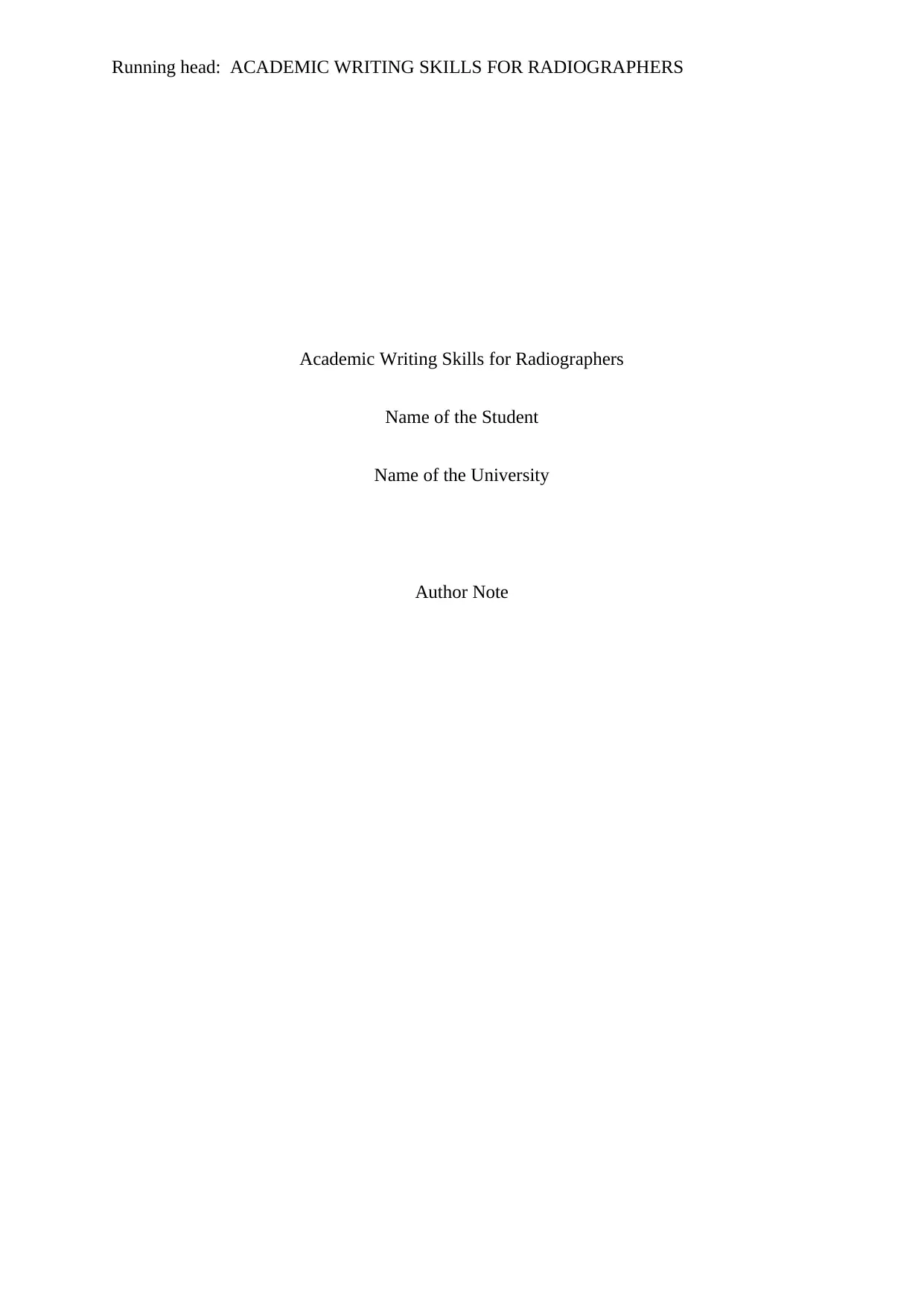
Running head: ACADEMIC WRITING SKILLS FOR RADIOGRAPHERS
Academic Writing Skills for Radiographers
Name of the Student
Name of the University
Author Note
Academic Writing Skills for Radiographers
Name of the Student
Name of the University
Author Note
Paraphrase This Document
Need a fresh take? Get an instant paraphrase of this document with our AI Paraphraser
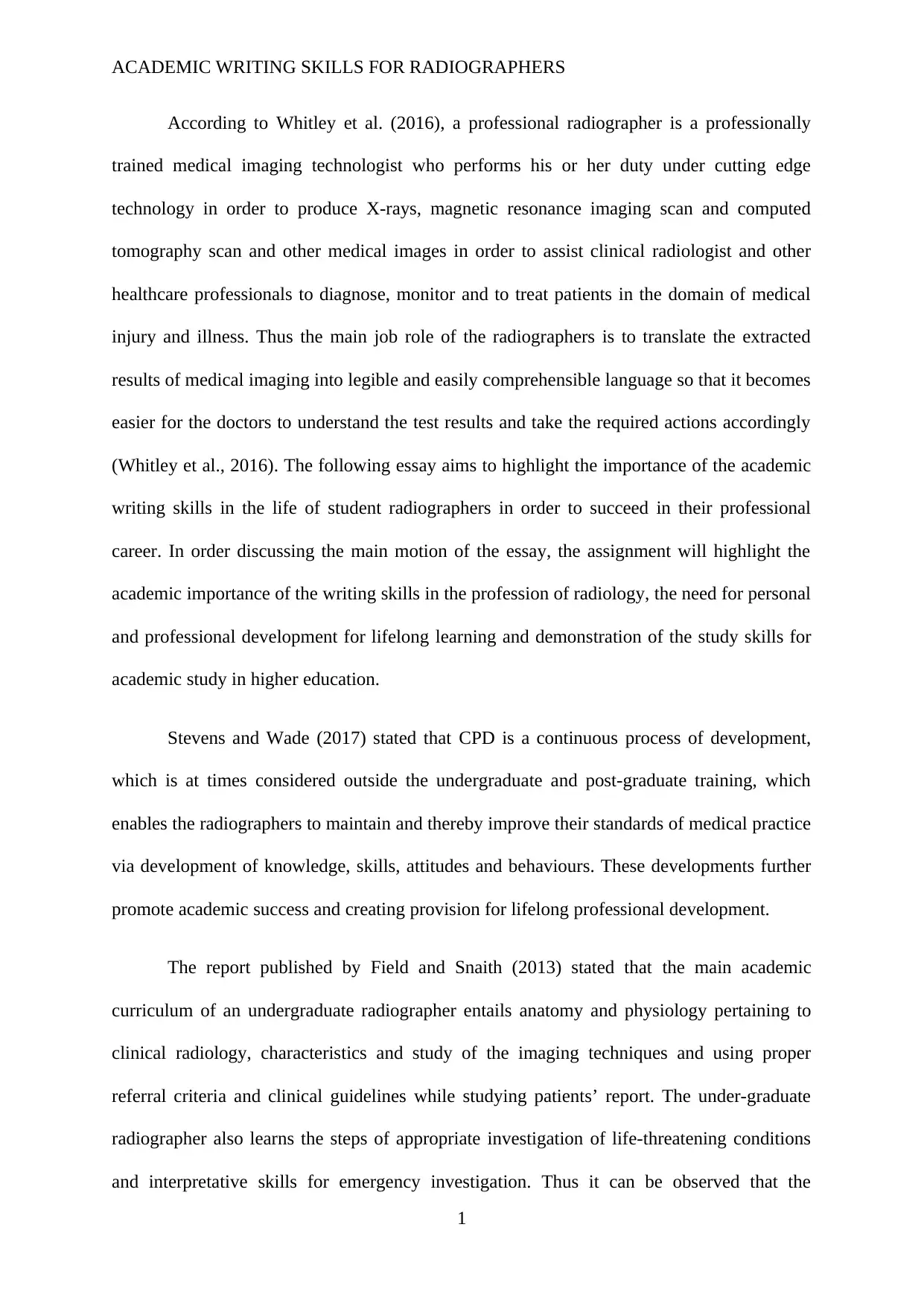
ACADEMIC WRITING SKILLS FOR RADIOGRAPHERS
According to Whitley et al. (2016), a professional radiographer is a professionally
trained medical imaging technologist who performs his or her duty under cutting edge
technology in order to produce X-rays, magnetic resonance imaging scan and computed
tomography scan and other medical images in order to assist clinical radiologist and other
healthcare professionals to diagnose, monitor and to treat patients in the domain of medical
injury and illness. Thus the main job role of the radiographers is to translate the extracted
results of medical imaging into legible and easily comprehensible language so that it becomes
easier for the doctors to understand the test results and take the required actions accordingly
(Whitley et al., 2016). The following essay aims to highlight the importance of the academic
writing skills in the life of student radiographers in order to succeed in their professional
career. In order discussing the main motion of the essay, the assignment will highlight the
academic importance of the writing skills in the profession of radiology, the need for personal
and professional development for lifelong learning and demonstration of the study skills for
academic study in higher education.
Stevens and Wade (2017) stated that CPD is a continuous process of development,
which is at times considered outside the undergraduate and post-graduate training, which
enables the radiographers to maintain and thereby improve their standards of medical practice
via development of knowledge, skills, attitudes and behaviours. These developments further
promote academic success and creating provision for lifelong professional development.
The report published by Field and Snaith (2013) stated that the main academic
curriculum of an undergraduate radiographer entails anatomy and physiology pertaining to
clinical radiology, characteristics and study of the imaging techniques and using proper
referral criteria and clinical guidelines while studying patients’ report. The under-graduate
radiographer also learns the steps of appropriate investigation of life-threatening conditions
and interpretative skills for emergency investigation. Thus it can be observed that the
1
According to Whitley et al. (2016), a professional radiographer is a professionally
trained medical imaging technologist who performs his or her duty under cutting edge
technology in order to produce X-rays, magnetic resonance imaging scan and computed
tomography scan and other medical images in order to assist clinical radiologist and other
healthcare professionals to diagnose, monitor and to treat patients in the domain of medical
injury and illness. Thus the main job role of the radiographers is to translate the extracted
results of medical imaging into legible and easily comprehensible language so that it becomes
easier for the doctors to understand the test results and take the required actions accordingly
(Whitley et al., 2016). The following essay aims to highlight the importance of the academic
writing skills in the life of student radiographers in order to succeed in their professional
career. In order discussing the main motion of the essay, the assignment will highlight the
academic importance of the writing skills in the profession of radiology, the need for personal
and professional development for lifelong learning and demonstration of the study skills for
academic study in higher education.
Stevens and Wade (2017) stated that CPD is a continuous process of development,
which is at times considered outside the undergraduate and post-graduate training, which
enables the radiographers to maintain and thereby improve their standards of medical practice
via development of knowledge, skills, attitudes and behaviours. These developments further
promote academic success and creating provision for lifelong professional development.
The report published by Field and Snaith (2013) stated that the main academic
curriculum of an undergraduate radiographer entails anatomy and physiology pertaining to
clinical radiology, characteristics and study of the imaging techniques and using proper
referral criteria and clinical guidelines while studying patients’ report. The under-graduate
radiographer also learns the steps of appropriate investigation of life-threatening conditions
and interpretative skills for emergency investigation. Thus it can be observed that the
1
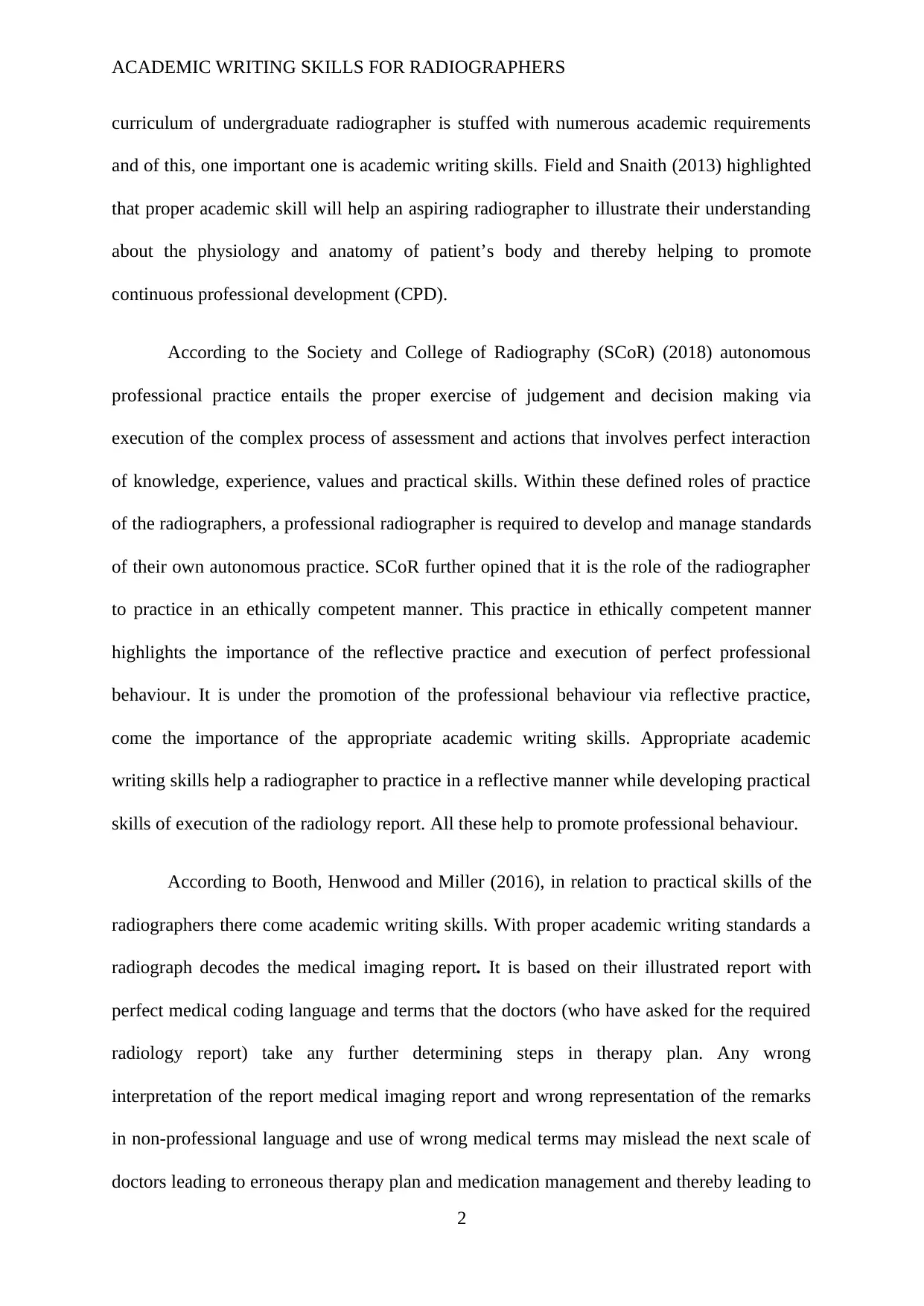
ACADEMIC WRITING SKILLS FOR RADIOGRAPHERS
curriculum of undergraduate radiographer is stuffed with numerous academic requirements
and of this, one important one is academic writing skills. Field and Snaith (2013) highlighted
that proper academic skill will help an aspiring radiographer to illustrate their understanding
about the physiology and anatomy of patient’s body and thereby helping to promote
continuous professional development (CPD).
According to the Society and College of Radiography (SCoR) (2018) autonomous
professional practice entails the proper exercise of judgement and decision making via
execution of the complex process of assessment and actions that involves perfect interaction
of knowledge, experience, values and practical skills. Within these defined roles of practice
of the radiographers, a professional radiographer is required to develop and manage standards
of their own autonomous practice. SCoR further opined that it is the role of the radiographer
to practice in an ethically competent manner. This practice in ethically competent manner
highlights the importance of the reflective practice and execution of perfect professional
behaviour. It is under the promotion of the professional behaviour via reflective practice,
come the importance of the appropriate academic writing skills. Appropriate academic
writing skills help a radiographer to practice in a reflective manner while developing practical
skills of execution of the radiology report. All these help to promote professional behaviour.
According to Booth, Henwood and Miller (2016), in relation to practical skills of the
radiographers there come academic writing skills. With proper academic writing standards a
radiograph decodes the medical imaging report. It is based on their illustrated report with
perfect medical coding language and terms that the doctors (who have asked for the required
radiology report) take any further determining steps in therapy plan. Any wrong
interpretation of the report medical imaging report and wrong representation of the remarks
in non-professional language and use of wrong medical terms may mislead the next scale of
doctors leading to erroneous therapy plan and medication management and thereby leading to
2
curriculum of undergraduate radiographer is stuffed with numerous academic requirements
and of this, one important one is academic writing skills. Field and Snaith (2013) highlighted
that proper academic skill will help an aspiring radiographer to illustrate their understanding
about the physiology and anatomy of patient’s body and thereby helping to promote
continuous professional development (CPD).
According to the Society and College of Radiography (SCoR) (2018) autonomous
professional practice entails the proper exercise of judgement and decision making via
execution of the complex process of assessment and actions that involves perfect interaction
of knowledge, experience, values and practical skills. Within these defined roles of practice
of the radiographers, a professional radiographer is required to develop and manage standards
of their own autonomous practice. SCoR further opined that it is the role of the radiographer
to practice in an ethically competent manner. This practice in ethically competent manner
highlights the importance of the reflective practice and execution of perfect professional
behaviour. It is under the promotion of the professional behaviour via reflective practice,
come the importance of the appropriate academic writing skills. Appropriate academic
writing skills help a radiographer to practice in a reflective manner while developing practical
skills of execution of the radiology report. All these help to promote professional behaviour.
According to Booth, Henwood and Miller (2016), in relation to practical skills of the
radiographers there come academic writing skills. With proper academic writing standards a
radiograph decodes the medical imaging report. It is based on their illustrated report with
perfect medical coding language and terms that the doctors (who have asked for the required
radiology report) take any further determining steps in therapy plan. Any wrong
interpretation of the report medical imaging report and wrong representation of the remarks
in non-professional language and use of wrong medical terms may mislead the next scale of
doctors leading to erroneous therapy plan and medication management and thereby leading to
2
⊘ This is a preview!⊘
Do you want full access?
Subscribe today to unlock all pages.

Trusted by 1+ million students worldwide
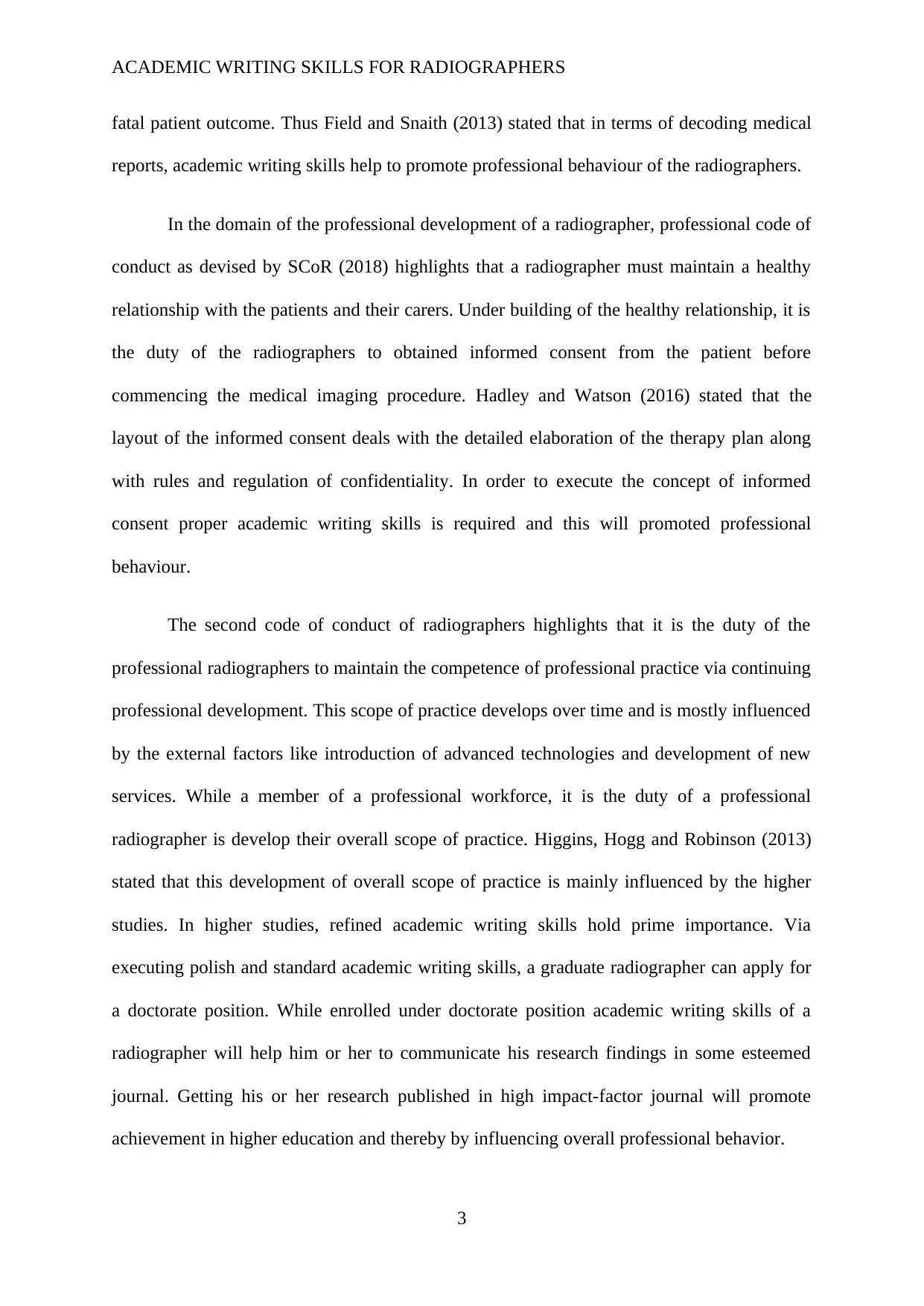
ACADEMIC WRITING SKILLS FOR RADIOGRAPHERS
fatal patient outcome. Thus Field and Snaith (2013) stated that in terms of decoding medical
reports, academic writing skills help to promote professional behaviour of the radiographers.
In the domain of the professional development of a radiographer, professional code of
conduct as devised by SCoR (2018) highlights that a radiographer must maintain a healthy
relationship with the patients and their carers. Under building of the healthy relationship, it is
the duty of the radiographers to obtained informed consent from the patient before
commencing the medical imaging procedure. Hadley and Watson (2016) stated that the
layout of the informed consent deals with the detailed elaboration of the therapy plan along
with rules and regulation of confidentiality. In order to execute the concept of informed
consent proper academic writing skills is required and this will promoted professional
behaviour.
The second code of conduct of radiographers highlights that it is the duty of the
professional radiographers to maintain the competence of professional practice via continuing
professional development. This scope of practice develops over time and is mostly influenced
by the external factors like introduction of advanced technologies and development of new
services. While a member of a professional workforce, it is the duty of a professional
radiographer is develop their overall scope of practice. Higgins, Hogg and Robinson (2013)
stated that this development of overall scope of practice is mainly influenced by the higher
studies. In higher studies, refined academic writing skills hold prime importance. Via
executing polish and standard academic writing skills, a graduate radiographer can apply for
a doctorate position. While enrolled under doctorate position academic writing skills of a
radiographer will help him or her to communicate his research findings in some esteemed
journal. Getting his or her research published in high impact-factor journal will promote
achievement in higher education and thereby by influencing overall professional behavior.
3
fatal patient outcome. Thus Field and Snaith (2013) stated that in terms of decoding medical
reports, academic writing skills help to promote professional behaviour of the radiographers.
In the domain of the professional development of a radiographer, professional code of
conduct as devised by SCoR (2018) highlights that a radiographer must maintain a healthy
relationship with the patients and their carers. Under building of the healthy relationship, it is
the duty of the radiographers to obtained informed consent from the patient before
commencing the medical imaging procedure. Hadley and Watson (2016) stated that the
layout of the informed consent deals with the detailed elaboration of the therapy plan along
with rules and regulation of confidentiality. In order to execute the concept of informed
consent proper academic writing skills is required and this will promoted professional
behaviour.
The second code of conduct of radiographers highlights that it is the duty of the
professional radiographers to maintain the competence of professional practice via continuing
professional development. This scope of practice develops over time and is mostly influenced
by the external factors like introduction of advanced technologies and development of new
services. While a member of a professional workforce, it is the duty of a professional
radiographer is develop their overall scope of practice. Higgins, Hogg and Robinson (2013)
stated that this development of overall scope of practice is mainly influenced by the higher
studies. In higher studies, refined academic writing skills hold prime importance. Via
executing polish and standard academic writing skills, a graduate radiographer can apply for
a doctorate position. While enrolled under doctorate position academic writing skills of a
radiographer will help him or her to communicate his research findings in some esteemed
journal. Getting his or her research published in high impact-factor journal will promote
achievement in higher education and thereby by influencing overall professional behavior.
3
Paraphrase This Document
Need a fresh take? Get an instant paraphrase of this document with our AI Paraphraser
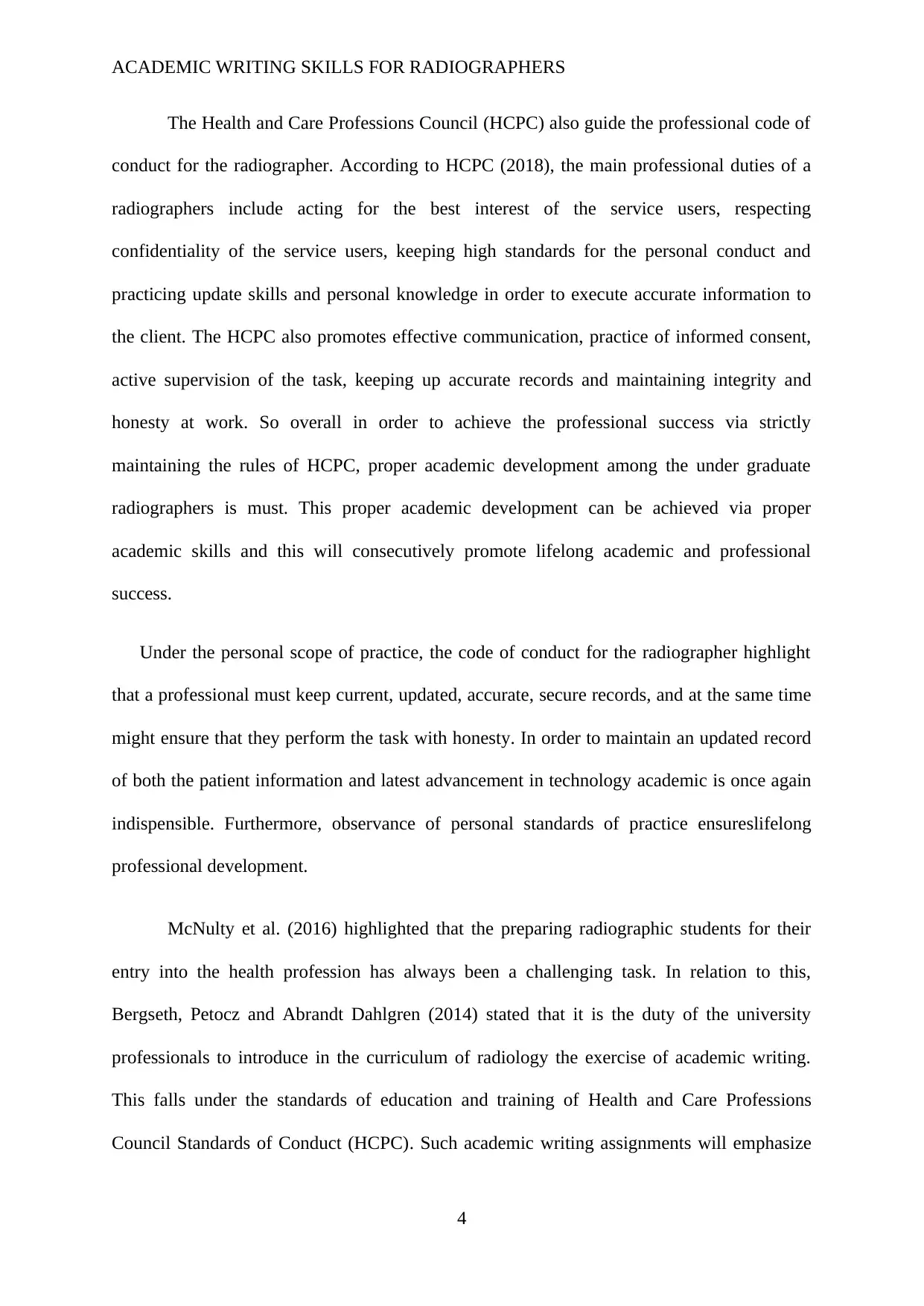
ACADEMIC WRITING SKILLS FOR RADIOGRAPHERS
The Health and Care Professions Council (HCPC) also guide the professional code of
conduct for the radiographer. According to HCPC (2018), the main professional duties of a
radiographers include acting for the best interest of the service users, respecting
confidentiality of the service users, keeping high standards for the personal conduct and
practicing update skills and personal knowledge in order to execute accurate information to
the client. The HCPC also promotes effective communication, practice of informed consent,
active supervision of the task, keeping up accurate records and maintaining integrity and
honesty at work. So overall in order to achieve the professional success via strictly
maintaining the rules of HCPC, proper academic development among the under graduate
radiographers is must. This proper academic development can be achieved via proper
academic skills and this will consecutively promote lifelong academic and professional
success.
Under the personal scope of practice, the code of conduct for the radiographer highlight
that a professional must keep current, updated, accurate, secure records, and at the same time
might ensure that they perform the task with honesty. In order to maintain an updated record
of both the patient information and latest advancement in technology academic is once again
indispensible. Furthermore, observance of personal standards of practice ensureslifelong
professional development.
McNulty et al. (2016) highlighted that the preparing radiographic students for their
entry into the health profession has always been a challenging task. In relation to this,
Bergseth, Petocz and Abrandt Dahlgren (2014) stated that it is the duty of the university
professionals to introduce in the curriculum of radiology the exercise of academic writing.
This falls under the standards of education and training of Health and Care Professions
Council Standards of Conduct (HCPC). Such academic writing assignments will emphasize
4
The Health and Care Professions Council (HCPC) also guide the professional code of
conduct for the radiographer. According to HCPC (2018), the main professional duties of a
radiographers include acting for the best interest of the service users, respecting
confidentiality of the service users, keeping high standards for the personal conduct and
practicing update skills and personal knowledge in order to execute accurate information to
the client. The HCPC also promotes effective communication, practice of informed consent,
active supervision of the task, keeping up accurate records and maintaining integrity and
honesty at work. So overall in order to achieve the professional success via strictly
maintaining the rules of HCPC, proper academic development among the under graduate
radiographers is must. This proper academic development can be achieved via proper
academic skills and this will consecutively promote lifelong academic and professional
success.
Under the personal scope of practice, the code of conduct for the radiographer highlight
that a professional must keep current, updated, accurate, secure records, and at the same time
might ensure that they perform the task with honesty. In order to maintain an updated record
of both the patient information and latest advancement in technology academic is once again
indispensible. Furthermore, observance of personal standards of practice ensureslifelong
professional development.
McNulty et al. (2016) highlighted that the preparing radiographic students for their
entry into the health profession has always been a challenging task. In relation to this,
Bergseth, Petocz and Abrandt Dahlgren (2014) stated that it is the duty of the university
professionals to introduce in the curriculum of radiology the exercise of academic writing.
This falls under the standards of education and training of Health and Care Professions
Council Standards of Conduct (HCPC). Such academic writing assignments will emphasize
4
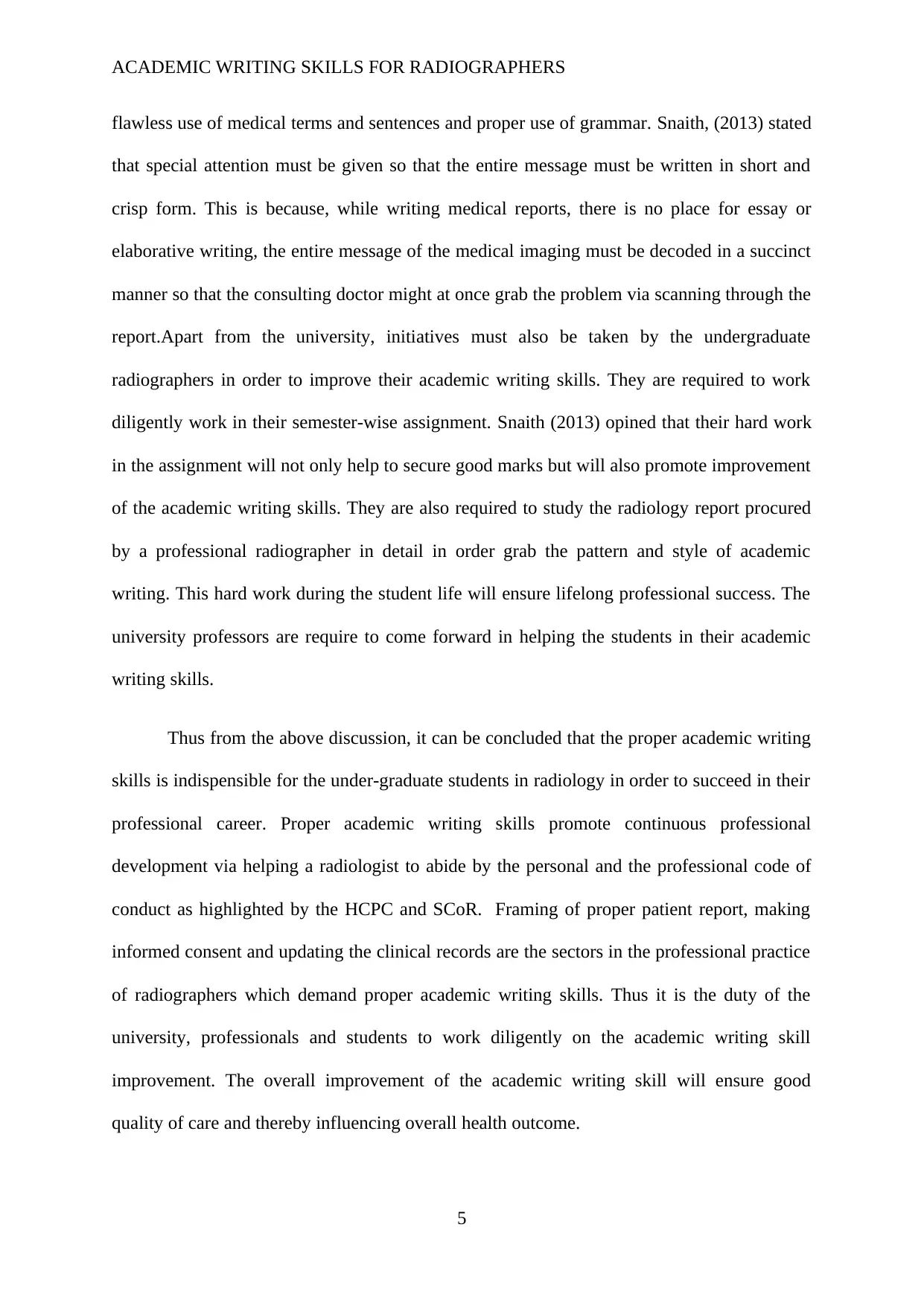
ACADEMIC WRITING SKILLS FOR RADIOGRAPHERS
flawless use of medical terms and sentences and proper use of grammar. Snaith, (2013) stated
that special attention must be given so that the entire message must be written in short and
crisp form. This is because, while writing medical reports, there is no place for essay or
elaborative writing, the entire message of the medical imaging must be decoded in a succinct
manner so that the consulting doctor might at once grab the problem via scanning through the
report.Apart from the university, initiatives must also be taken by the undergraduate
radiographers in order to improve their academic writing skills. They are required to work
diligently work in their semester-wise assignment. Snaith (2013) opined that their hard work
in the assignment will not only help to secure good marks but will also promote improvement
of the academic writing skills. They are also required to study the radiology report procured
by a professional radiographer in detail in order grab the pattern and style of academic
writing. This hard work during the student life will ensure lifelong professional success. The
university professors are require to come forward in helping the students in their academic
writing skills.
Thus from the above discussion, it can be concluded that the proper academic writing
skills is indispensible for the under-graduate students in radiology in order to succeed in their
professional career. Proper academic writing skills promote continuous professional
development via helping a radiologist to abide by the personal and the professional code of
conduct as highlighted by the HCPC and SCoR. Framing of proper patient report, making
informed consent and updating the clinical records are the sectors in the professional practice
of radiographers which demand proper academic writing skills. Thus it is the duty of the
university, professionals and students to work diligently on the academic writing skill
improvement. The overall improvement of the academic writing skill will ensure good
quality of care and thereby influencing overall health outcome.
5
flawless use of medical terms and sentences and proper use of grammar. Snaith, (2013) stated
that special attention must be given so that the entire message must be written in short and
crisp form. This is because, while writing medical reports, there is no place for essay or
elaborative writing, the entire message of the medical imaging must be decoded in a succinct
manner so that the consulting doctor might at once grab the problem via scanning through the
report.Apart from the university, initiatives must also be taken by the undergraduate
radiographers in order to improve their academic writing skills. They are required to work
diligently work in their semester-wise assignment. Snaith (2013) opined that their hard work
in the assignment will not only help to secure good marks but will also promote improvement
of the academic writing skills. They are also required to study the radiology report procured
by a professional radiographer in detail in order grab the pattern and style of academic
writing. This hard work during the student life will ensure lifelong professional success. The
university professors are require to come forward in helping the students in their academic
writing skills.
Thus from the above discussion, it can be concluded that the proper academic writing
skills is indispensible for the under-graduate students in radiology in order to succeed in their
professional career. Proper academic writing skills promote continuous professional
development via helping a radiologist to abide by the personal and the professional code of
conduct as highlighted by the HCPC and SCoR. Framing of proper patient report, making
informed consent and updating the clinical records are the sectors in the professional practice
of radiographers which demand proper academic writing skills. Thus it is the duty of the
university, professionals and students to work diligently on the academic writing skill
improvement. The overall improvement of the academic writing skill will ensure good
quality of care and thereby influencing overall health outcome.
5
⊘ This is a preview!⊘
Do you want full access?
Subscribe today to unlock all pages.

Trusted by 1+ million students worldwide
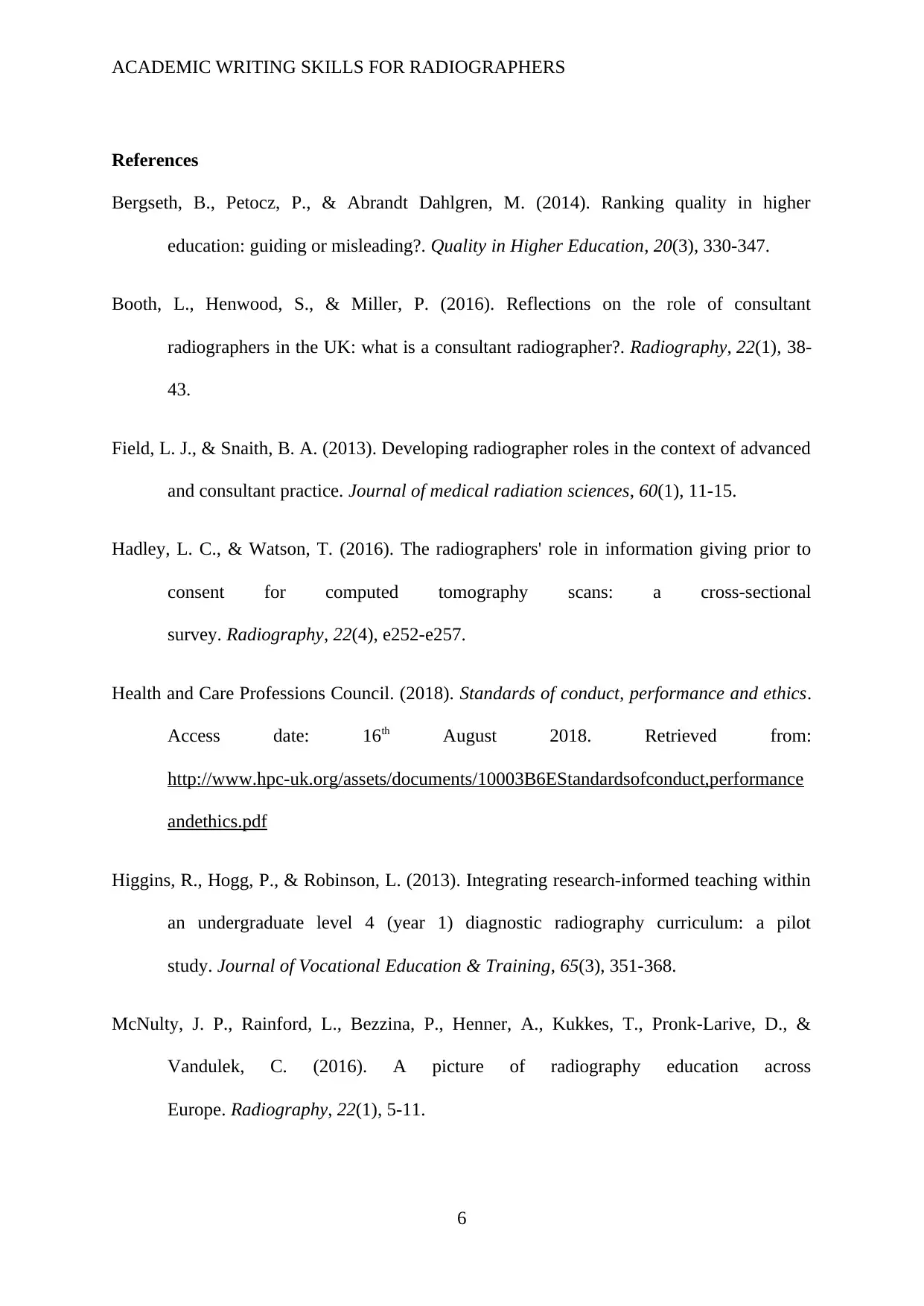
ACADEMIC WRITING SKILLS FOR RADIOGRAPHERS
References
Bergseth, B., Petocz, P., & Abrandt Dahlgren, M. (2014). Ranking quality in higher
education: guiding or misleading?. Quality in Higher Education, 20(3), 330-347.
Booth, L., Henwood, S., & Miller, P. (2016). Reflections on the role of consultant
radiographers in the UK: what is a consultant radiographer?. Radiography, 22(1), 38-
43.
Field, L. J., & Snaith, B. A. (2013). Developing radiographer roles in the context of advanced
and consultant practice. Journal of medical radiation sciences, 60(1), 11-15.
Hadley, L. C., & Watson, T. (2016). The radiographers' role in information giving prior to
consent for computed tomography scans: a cross-sectional
survey. Radiography, 22(4), e252-e257.
Health and Care Professions Council. (2018). Standards of conduct, performance and ethics.
Access date: 16th August 2018. Retrieved from:
http://www.hpc-uk.org/assets/documents/10003B6EStandardsofconduct,performance
andethics.pdf
Higgins, R., Hogg, P., & Robinson, L. (2013). Integrating research-informed teaching within
an undergraduate level 4 (year 1) diagnostic radiography curriculum: a pilot
study. Journal of Vocational Education & Training, 65(3), 351-368.
McNulty, J. P., Rainford, L., Bezzina, P., Henner, A., Kukkes, T., Pronk-Larive, D., &
Vandulek, C. (2016). A picture of radiography education across
Europe. Radiography, 22(1), 5-11.
6
References
Bergseth, B., Petocz, P., & Abrandt Dahlgren, M. (2014). Ranking quality in higher
education: guiding or misleading?. Quality in Higher Education, 20(3), 330-347.
Booth, L., Henwood, S., & Miller, P. (2016). Reflections on the role of consultant
radiographers in the UK: what is a consultant radiographer?. Radiography, 22(1), 38-
43.
Field, L. J., & Snaith, B. A. (2013). Developing radiographer roles in the context of advanced
and consultant practice. Journal of medical radiation sciences, 60(1), 11-15.
Hadley, L. C., & Watson, T. (2016). The radiographers' role in information giving prior to
consent for computed tomography scans: a cross-sectional
survey. Radiography, 22(4), e252-e257.
Health and Care Professions Council. (2018). Standards of conduct, performance and ethics.
Access date: 16th August 2018. Retrieved from:
http://www.hpc-uk.org/assets/documents/10003B6EStandardsofconduct,performance
andethics.pdf
Higgins, R., Hogg, P., & Robinson, L. (2013). Integrating research-informed teaching within
an undergraduate level 4 (year 1) diagnostic radiography curriculum: a pilot
study. Journal of Vocational Education & Training, 65(3), 351-368.
McNulty, J. P., Rainford, L., Bezzina, P., Henner, A., Kukkes, T., Pronk-Larive, D., &
Vandulek, C. (2016). A picture of radiography education across
Europe. Radiography, 22(1), 5-11.
6
Paraphrase This Document
Need a fresh take? Get an instant paraphrase of this document with our AI Paraphraser
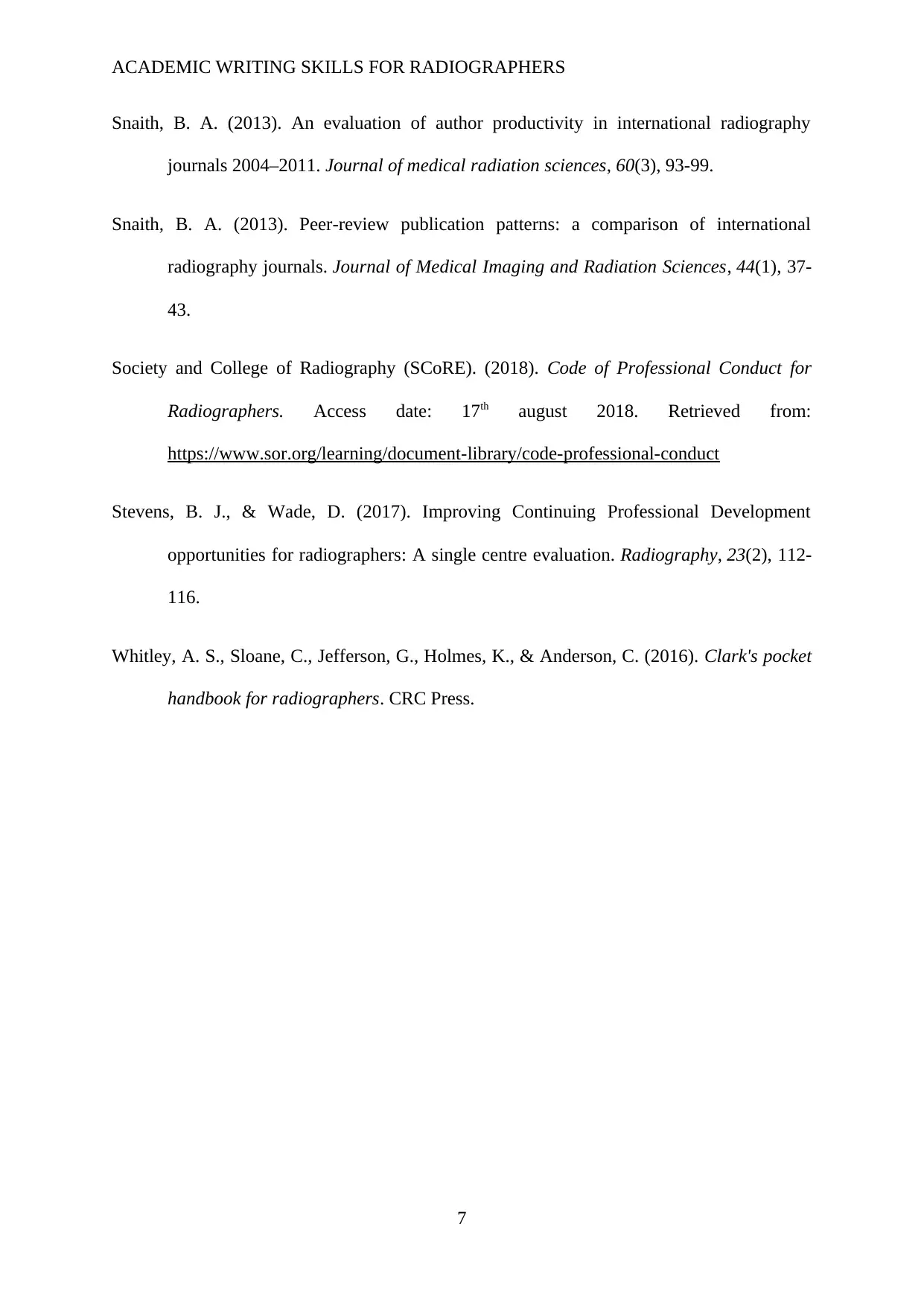
ACADEMIC WRITING SKILLS FOR RADIOGRAPHERS
Snaith, B. A. (2013). An evaluation of author productivity in international radiography
journals 2004–2011. Journal of medical radiation sciences, 60(3), 93-99.
Snaith, B. A. (2013). Peer-review publication patterns: a comparison of international
radiography journals. Journal of Medical Imaging and Radiation Sciences, 44(1), 37-
43.
Society and College of Radiography (SCoRE). (2018). Code of Professional Conduct for
Radiographers. Access date: 17th august 2018. Retrieved from:
https://www.sor.org/learning/document-library/code-professional-conduct
Stevens, B. J., & Wade, D. (2017). Improving Continuing Professional Development
opportunities for radiographers: A single centre evaluation. Radiography, 23(2), 112-
116.
Whitley, A. S., Sloane, C., Jefferson, G., Holmes, K., & Anderson, C. (2016). Clark's pocket
handbook for radiographers. CRC Press.
7
Snaith, B. A. (2013). An evaluation of author productivity in international radiography
journals 2004–2011. Journal of medical radiation sciences, 60(3), 93-99.
Snaith, B. A. (2013). Peer-review publication patterns: a comparison of international
radiography journals. Journal of Medical Imaging and Radiation Sciences, 44(1), 37-
43.
Society and College of Radiography (SCoRE). (2018). Code of Professional Conduct for
Radiographers. Access date: 17th august 2018. Retrieved from:
https://www.sor.org/learning/document-library/code-professional-conduct
Stevens, B. J., & Wade, D. (2017). Improving Continuing Professional Development
opportunities for radiographers: A single centre evaluation. Radiography, 23(2), 112-
116.
Whitley, A. S., Sloane, C., Jefferson, G., Holmes, K., & Anderson, C. (2016). Clark's pocket
handbook for radiographers. CRC Press.
7
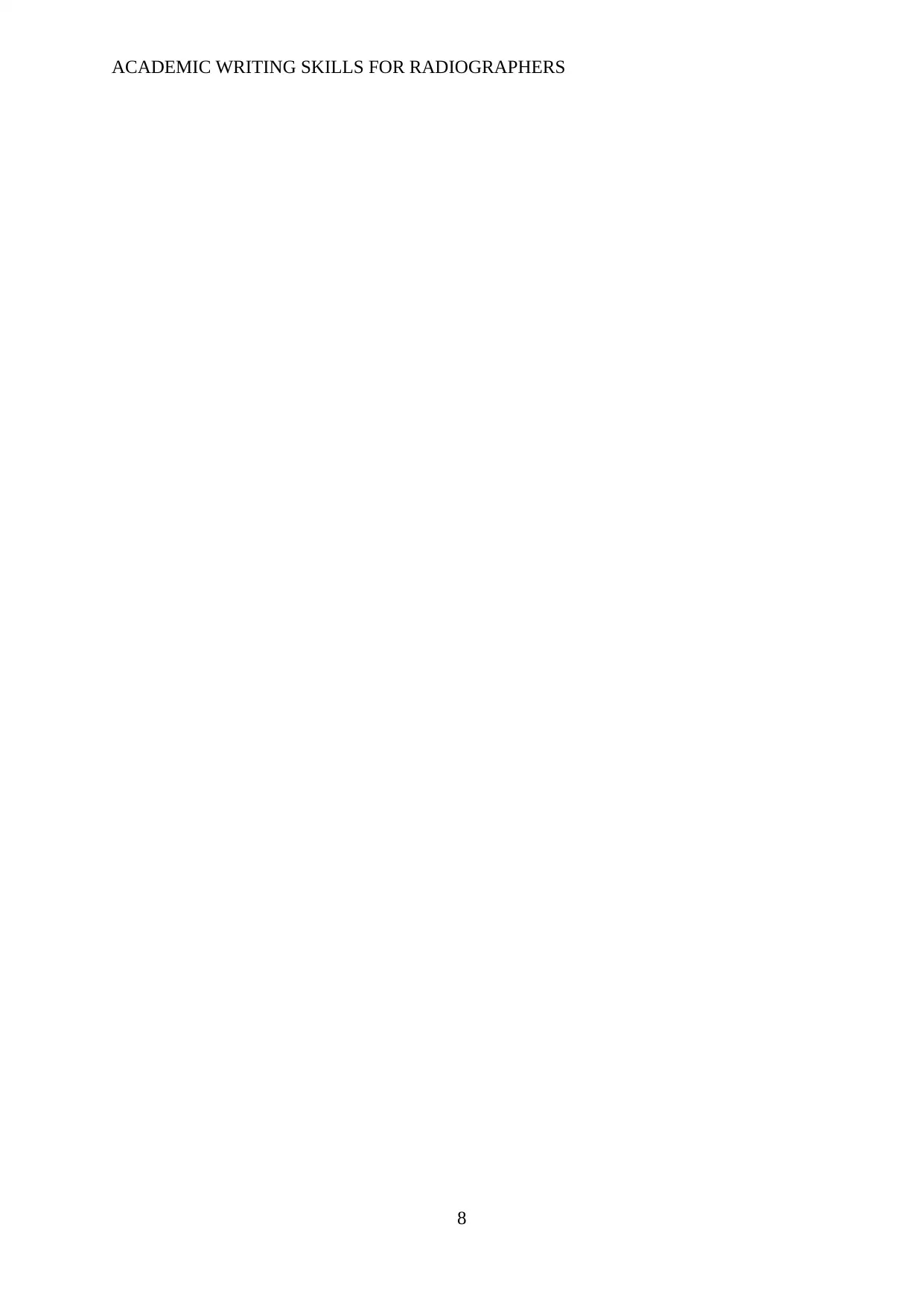
ACADEMIC WRITING SKILLS FOR RADIOGRAPHERS
8
8
⊘ This is a preview!⊘
Do you want full access?
Subscribe today to unlock all pages.

Trusted by 1+ million students worldwide
1 out of 9
Your All-in-One AI-Powered Toolkit for Academic Success.
+13062052269
info@desklib.com
Available 24*7 on WhatsApp / Email
![[object Object]](/_next/static/media/star-bottom.7253800d.svg)
Unlock your academic potential
Copyright © 2020–2025 A2Z Services. All Rights Reserved. Developed and managed by ZUCOL.